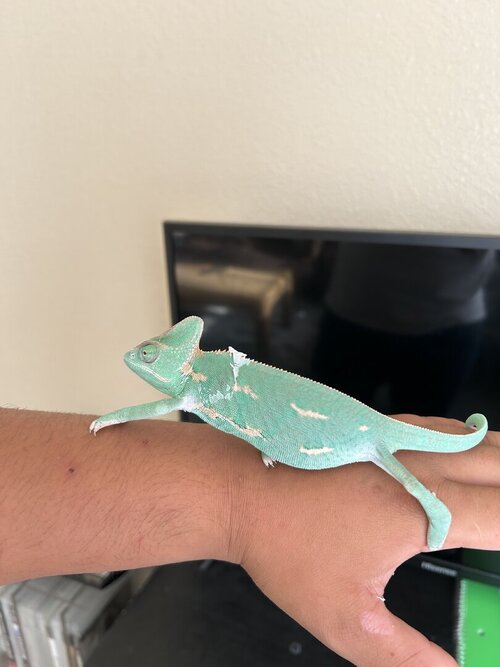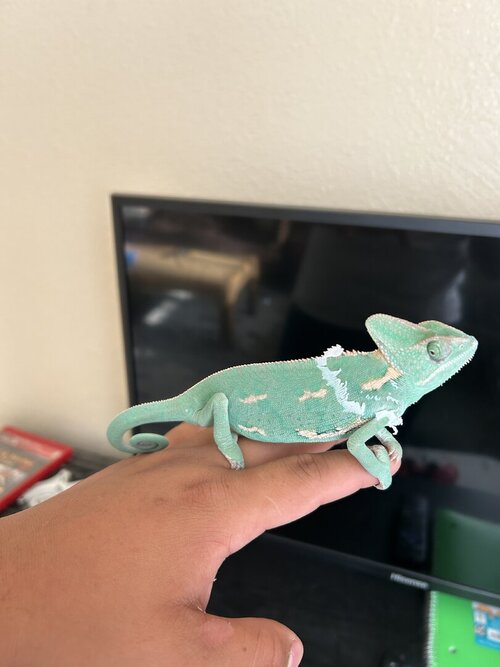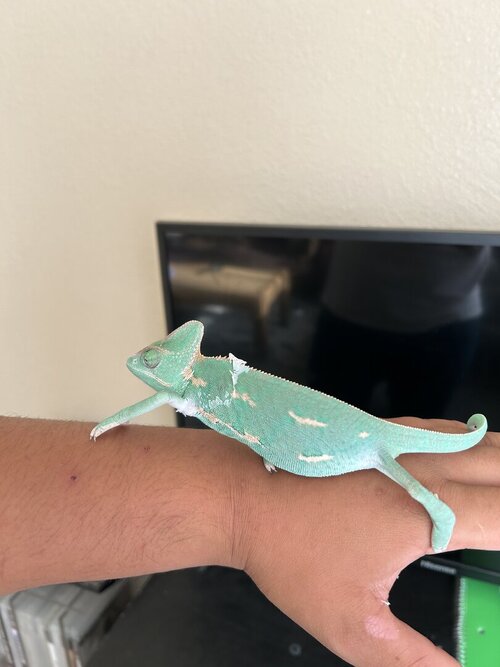Navigation
Install the app
How to install the app on iOS
Follow along with the video below to see how to install our site as a web app on your home screen.
Note: This feature may not be available in some browsers.
More options
You are using an out of date browser. It may not display this or other websites correctly.
You should upgrade or use an alternative browser.
You should upgrade or use an alternative browser.
How much to feed
- Thread starter IsaacLuvslucky
- Start date
SteveH
Chameleon Enthusiast
A variety of feeders is key. Many of us feed as much as they will eat everyday until around 10 months to a year of age then cut back to 3-5 size appropriate feeders every other day.How much crickets should I feed my chameleon a day? Some one had told me to cut down she was eating 75 a week approximately View attachment 339875View attachment 339876View attachment 339877
Attachments
IsaacLuvslucky
Member
I don’t think my Chameleon is that old I’d say around 3-4 months old so do I continue feeding her 10 a day?
The issues are egg production and growth….we want the females to be able to attain full growth, but we don’t want to put them in a position of producing large clutches of eggs and becoming egg bound or developing follicular stasis, MBD, etc. Some mature earlier than others….so it’s hard to figure out when to start the controlling of the food and temperatures.
Part of the problem is that, to keep the follicular stasis and egg binding from happening and keep the clutch size low, we need to control the amount of food they get and the temperatures starting just around the time they become sexually mature….but being that we have to “guess” when this is going to happen, since we aren’t vets and have no other way to determine when this is happening, until we see the mature colouration appearing….it’s hard to tell anyone when to start this ”diet”.
Part of the problem is that, to keep the follicular stasis and egg binding from happening and keep the clutch size low, we need to control the amount of food they get and the temperatures starting just around the time they become sexually mature….but being that we have to “guess” when this is going to happen, since we aren’t vets and have no other way to determine when this is happening, until we see the mature colouration appearing….it’s hard to tell anyone when to start this ”diet”.
lee jian heng
Member
Hi,could you teach me any detail trick to lower female production,I want to minimize she egg number and egg size.What I currently know is,feed 3 insect every other day,and lower temperature.The issues are egg production and growth….we want the females to be able to attain full growth, but we don’t want to put them in a position of producing large clutches of eggs and becoming egg bound or developing follicular stasis, MBD, etc. Some mature earlier than others….so it’s hard to figure out when to start the controlling of the food and temperatures.
Part of the problem is that, to keep the follicular stasis and egg binding from happening and keep the clutch size low, we need to control the amount of food they get and the temperatures starting just around the time they become sexually mature….but being that we have to “guess” when this is going to happen, since we aren’t vets and have no other way to determine when this is happening, until we see the mature colouration appearing….it’s hard to tell anyone when to start this ”diet”.
When a female veiled chameleon is young and not sexually mature yet (doesn’t have her mustard yellow splotches and blue dots), as she approaches sexual maturity, putting her on the diet and temperature regime we recommend, helps to control the number of follicles that grow to ovulate and become eggs, so the clutch size will be around 2 dozen eggs. It should prevent follicular stasis and egg binding from occurring.
The issues with this are that we can’t tell exactly when she is going to reach sexual maturity or exactly when she will be full grown either…so we kind of have to guess or do the best we can at figuring out when to start.
Generally we start to cut back first, to feeding the same number of insects every second day when they are maybe 5 months old (it varies)…then gradually cutting down the number of insects to 3 or 4, two or three times a week. At the same time we have the basking temperature at 80F to slow her metabolism a bit so she’s not so hungry.
With some females, this “regime” will lower the number of eggs produced, with some it will soon cut the reproduction out completely. I think we’re going to find that this difference is partly due to the supplements we use and what we gutload/feed the insects with and what insects we feed the chameleons even….more work needs to be done on the details.
The issues with this are that we can’t tell exactly when she is going to reach sexual maturity or exactly when she will be full grown either…so we kind of have to guess or do the best we can at figuring out when to start.
Generally we start to cut back first, to feeding the same number of insects every second day when they are maybe 5 months old (it varies)…then gradually cutting down the number of insects to 3 or 4, two or three times a week. At the same time we have the basking temperature at 80F to slow her metabolism a bit so she’s not so hungry.
With some females, this “regime” will lower the number of eggs produced, with some it will soon cut the reproduction out completely. I think we’re going to find that this difference is partly due to the supplements we use and what we gutload/feed the insects with and what insects we feed the chameleons even….more work needs to be done on the details.
Lt.WorfReportingForDuty
Established Member
Interesting! I knew most of these were options but I’ve never thought about feeding snails! Haha. Wonder how that shell would come out.A variety of feeders is key. Many of us feed as much as they will eat everyday until around 10 months to a year of age then cut back to 3-5 size appropriate feeders every other day.
Similar threads
- Replies
- 4
- Views
- 885








